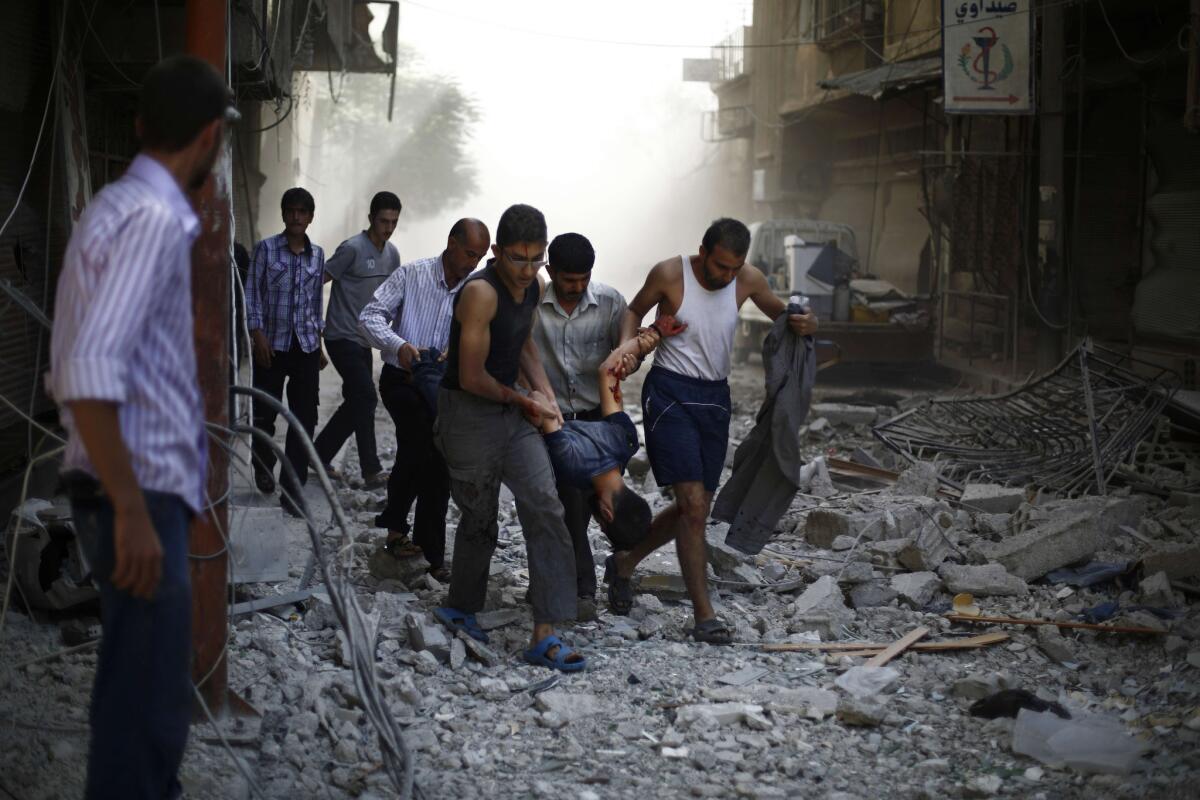Pentagon is shifting its tactics on backing fighters in Syria

Syrians carry a wounded man after airstrikes hit the rebel-held town of Duma in 2015.
- Share via
reporting from London — President Obama has decided to end the Pentagon’s failed effort to field its own proxy force in Syria, the administration announced Friday.
Instead of trying to back a moderate Syrian rebel force that the U.S. would train and equip, the administration will focus on supporting the Kurds and other established rebel groups in the country’s civil war, according to officials familiar with the plan.
The Pentagon “will provide equipment packages and weapons to a select group of vetted leaders and their units so that over time they can make a concerted push into territory still controlled by ISIL,” Pentagon Press Secretary Peter Cook said in a statement, referring to the Islamic State militia that controls large parts of northern and eastern Syria and is the main U.S. target in the country.
“We will monitor the progress these groups make and provide them with air support as they take the fight to ISIL,” Cook said.
The decision comes amid continued heavy fighting in Syria that illustrated the complex, deadly interaction of outside powers that have intervened in the country and the numerous armed groups that are trying to overthrow the government of President Bashar Assad while attacking one another.
In the region around Aleppo in northern Syria, Islamic State extremists stormed positions held by other rebel militias Friday, according to the group and another organization in the Syrian opposition.
Islamic State’s media office in Aleppo province said that “soldiers of the caliphate” had overrun six villages. The Syrian Observatory for Human Rights, a group based in London, described the gain as “one of the largest advances the Islamic State has achieved in Aleppo province for months.”
Iran’s Revolutionary Guard Corps, meanwhile, acknowledged in a statement that one of its commanders, Brig. Gen. Hossein Hamadani, had been killed near Aleppo. Iran and Russia have been the two key allies for Assad in his struggle to hang on to power in Syria.
Russia continued its bombardment of the country, with its Defense Ministry saying it had carried out 67 sorties against 60 targets across northern Syria over the preceding 24 hours. The statement claimed that the strikes had killed 300 militants and two senior Islamic State field commanders.
The U.S. wants to see Assad removed from power but has focused its attention on Islamic State militants, who oppose Assad but have also attacked U.S. allies, killed American captives and threatened terrorist attacks. With its Arab allies, the U.S. has conducted airstrikes targeting what it says are Islamic State positions, though the Obama administration has been reluctant to get too closely involved in supporting the various warring militias.
Establishing a U.S.-backed proxy force was seen last year as a significant escalation of American involvement, but the program started slowly and never succeeded.
The plan involved selecting potential fighters from moderate Syrian rebel groups, taking them out of the country to camps and giving them arms, equipment and six weeks of training to create a force that could tackle Islamic State fighters. The effort has been a thorough failure, as officials have conceded.
Just 125 fighters — instead of the originally envisioned 5,400 or more — were trained before the Pentagon put the effort on hold last month.
The first 54 recruits were ambushed by Al Nusra Front, an Al Qaeda affiliate, after they crossed back into Syria. The second class of 71 surrendered much of their U.S.-issued ammunition and trucks to Al Nusra Front fighters in exchange for safe passage.
The program initially was envisioned as a three-year plan to recruit, train and equip fighters at bases in Jordan, Qatar, Saudi Arabia and Turkey.
Thousands of rebels applied, but each one had to be vetted by the U.S in a process that often took months. Many were underage or had militant backgrounds, which made them ineligible.
The prospective host countries and many of the fighters disagreed with the U.S. emphasis on fighting Islamic State, saying the training should focus on ousting Assad. As Obama conceded in a recent news conference, many of the fighters objected to U.S. efforts to push them into fighting Islamic State in eastern Syria rather than Assad’s forces in the western part of the country.
In the end, only Turkey and Jordan hosted training. Of the $500 million Congress appropriated last year for the effort, $41.8 million had been spent as of May.
“We have clearly faced challenges with the train-and-equip program,” said one senior administration official familiar with the discussions who was not authorized to speak about the program publicly.
By contrast, the Kurdish militia has proved to be a more organized and trained ground force. With help from U.S. airstrikes, Kurdish fighters in Syria defeated Islamic State forces in the town of Kobani near the Turkish border in January after a yearlong siege. In June, the Kurds beat the militants again in the Syrian border town of Tal Abyad and cut a crucial Islamic State supply line for weapons and reinforcements funneling in throughTurkey.
“That’s the kind of more-effective approach we’re looking at,” Defense Secretary Ashton Carter said Friday in London.
“The work we’ve done with the Kurds in northern Syria is an example of an effective approach where you have a group that is capable, motivated on the ground and you can enable their success,” he said. “That’s exactly the kind of example that we’d like to pursue with other groups in other parts of Syria.”
Under the new plan, the U.S. will no longer vet individual fighters. Instead, it will provide communication equipment, weapons and ammunition to rebel commanders whom the U.S. will vet in an effort to ensure that they do not have links to extremist groups.
If the new plan works, those commanders will receive the equipment, distribute it among their units and push into territory controlled by Islamic State.
“A lot of this vetting of key leaders has already taken place,” said a senior U.S. defense official, who discussed the plan on condition of anonymity because he was not authorized to speak about it publicly.
Still, officials acknowledged the risk that arms given to those groups could find their way to militants the U.S. opposes. To reduce the risk, the U.S. will be providing “more basic kinds of equipment to these groups” rather than higher-end materiel, said Christine Wormuth, undersecretary of Defense for policy and a principal assistant to Carter. Other officials did not rule out offering some of the groups weapons such as shoulder-launched missiles in the future.
That approach involves new complications. U.S. aid to the Kurdish fighters in Syria has, for example, been a source of tension with Turkey, which sees the Kurds as a threat. But White House officials insisted that they had discussed the new plans with the Turks.
“We’re working extremely closely with Turkey throughout this process,” said Brett McGurk, deputy special presidential envoy to the Global Coalition to Counter ISIL. Several key operations and tactical positions depend on continued Turkish support, he said.
Meantime, about 1,000 recruits are waiting to complete training and return to Syria, according to U.S. officials. Fighters now at the U.S.-run training camps will remain there for an undetermined period as the Pentagon rolls out its new program, the officials said.
Rebels connected to groups supported under a separate CIA program said Friday that the change in the Pentagon’s plans would not affect them.
Hennigan reported from London and Parsons from Washington. Times staff writer Brian Bennett in Washington and special correspondent Nabih Bulos in Beirut contributed to this report.
ALSO:
Nobel Peace Prize awarded to National Dialogue Quartet in Tunisia
The night the hospital in Kunduz became a U.S. military target
Syrians announce a second offensive backed by Russian warplanes
More to Read
Sign up for Essential California
The most important California stories and recommendations in your inbox every morning.
You may occasionally receive promotional content from the Los Angeles Times.















